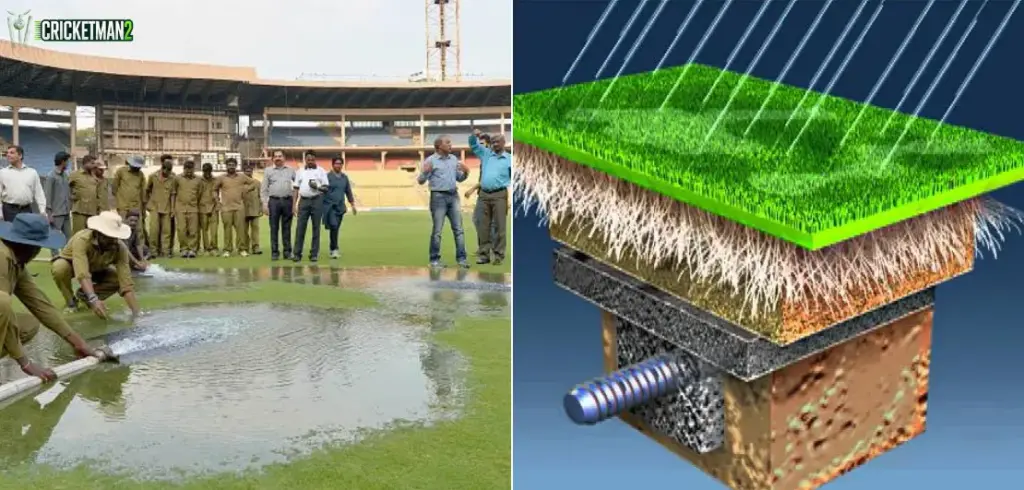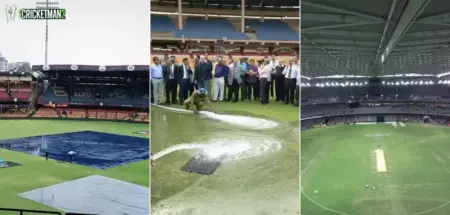Rain has always been one of cricket’s biggest spoilers — stopping matches, frustrating fans, and causing huge financial losses. But one technology has transformed the way stadiums handle rain in India: the SubAir drainage system. First installed at M. Chinnaswamy Stadium in Bengaluru, this American innovation ensures play can resume within minutes after rain stops, redefining how cricket adapts to weather interruptions.
The Origin of SubAir System in Cricket
The Karnataka State Cricket Association (KSCA) introduced the SubAir System in 2017, making M. Chinnaswamy Stadium the first cricket ground in the world to use this technology. Installed at a cost of around ₹4.25–₹4.5 crore, the project was executed by Great Sports Infra, the official partner of SubAir, USA.
Initially designed for golf courses, baseball, and football stadiums, SubAir’s success in Bengaluru has made it a model for other cricket venues globally.
Ready for a full innings at Chinnaswamy Stadium!
— Mr. Perfect (@DS24IN) May 17, 2024
With its top-notch Sub Air drainage and aeration system, we're all set for an uninterrupted cricket spectacle on May 18th.
Fingers crossed for clear skies and a fantastic match! #RCBvsCSK #RCBvCSK
pic.twitter.com/NhB26bkLZa
How Does the SubAir System Work?
The SubAir System is an advanced subsurface aeration and vacuum-powered drainage technology that operates in two modes — suction and pressure.
| Mode | Function | Description |
|---|---|---|
| Suction Mode | Water Drainage | Works like a vacuum, drawing out up to 10,000 litres of water per minute through perforated pipes beneath the field. Starts automatically as soon as rain begins. |
| Pressure Mode | Aeration | Pumps oxygen into the soil to keep the turf healthy and dry, ensuring stronger roots and better playing conditions. |
The system is powered by a 200-horsepower machine, connected to a network of sand-based layers and drainage pipes built according to USGA (United States Golf Association) standards.
Read Also:- Largest Cricket Stadiums in the World 2025
Why Chinnaswamy Stadium Leads the Way
M. Chinnaswamy Stadium’s SubAir System ensures the ground is match-ready within just 15 minutes after rain stops. This technology eliminates waterlogging and prevents washouts, making it one of the fastest-draining cricket fields in the world.
Key Features of the System
- Automated Sensors: Detect water accumulation and activate drainage instantly.
- Aeration Function: Runs throughout the year to keep grass healthy and prevent fungal growth.
- Sand-Based Outfield: Allows faster water percolation compared to traditional red soil.
- Water Recycling: The system collects and reuses drained water, contributing to sustainable management.
IPL 2025 Example: RCB vs PBKS at Chinnaswamy
During the IPL 2025 RCB vs PBKS match, heavy rain threatened to wash out the game. However, thanks to the SubAir system, the field was cleared within minutes, and play resumed shortly after.
The system drained three inches of rainwater in under 30 minutes, preventing the match from being abandoned — a perfect demonstration of how technology safeguards cricket from unpredictable weather.
Benefits of SubAir System
| Aspect | Advantage |
|---|---|
| Drainage Speed | Removes 10,000 litres/min; playable in 15–30 minutes after rain. |
| Pitch Protection | Prevents water pooling and maintains even playing surfaces. |
| Turf Health | Promotes root aeration, reduces disease and black layer formation. |
| Player Safety | Reduces risk of slips or injuries due to wet patches. |
| Energy Efficiency | Automated system minimizes manual maintenance. |
| Sustainability | Recycles drained water for irrigation and groundwater recharge. |
Why BCCI Should Expand SubAir Systems
Despite its success in Bengaluru, the SubAir system isn’t installed in other major Indian cricket grounds like Eden Gardens or Wankhede. This raises the question — why not make it a national standard?
Installing the system across India’s stadiums would drastically reduce rain-related disruptions, ensuring fans enjoy uninterrupted action and broadcasters face fewer losses.
Challenges for Nationwide Installation
- High Setup Cost: ₹4–₹5 crore per ground, plus ~₹7 lakh annual maintenance.
- Soil Adaptation: Each stadium’s base needs customization (sand replacement, pipe layout).
- Downtime: Grounds remain closed for several months during installation.
Even with these challenges, the long-term benefits — consistent matches, player safety, and better fan experience — make it a worthwhile investment.
Global Perspective
SubAir Systems are already used in over 500 international venues, including those for the NFL, FIFA World Cups, and top-tier golf courses. With India’s unpredictable monsoon climate and a packed cricket calendar, adopting this across major cities like Mumbai, Chennai, Delhi, and Kolkata could revolutionize the domestic cricketing infrastructure.
Read Also:- Cricket Stadiums with the Biggest Boundaries in the World
Conclusion
The SubAir System represents the future of cricket ground management. From instant drainage to eco-friendly water use, it ensures matches continue even after heavy downpours — a blessing for both players and fans.
As India’s cricketing calendar grows busier and global attention increases, the BCCI’s investment in such technology will be a step toward making Indian stadiums truly world-class and weather-proof.




